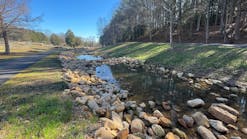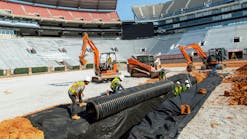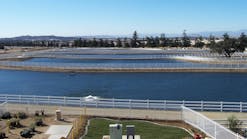The University of South Florida (USF) wanted to maximize the development potential of its main Tampa campus as it struggled to provide new facilities for its rapidly growing student population. Moreover, the university wanted to expand, but is physically constrained by four major thoroughfares that define the campus perimeter—and all the while, regulatory criteria continue to become more stringent.
The recent design for the master-planned wet detention pond, which provides both water quality and flood control benefits for the east basin of the USF campus, utilized a Thirsty Duck floating outlet and skimmer to accomplish a number of performance objectives:
- Optimize the pond discharge hydraulics in order to reduce the overall detention volume;
- Meet the current peak allowable discharge rate and peak stage criteria;
- Allow for an increase in the minimum discharge elevation as a means to increase permanent pool volume and residence time; and
- Maintain the existing geometry and size of the pond (i.e., no earthwork effort).
These objectives were challenged further by the recent adoption of a nutrient total maximum daily load for Cypress Creek, an Outstanding Florida Waterway that serves as the outfall for the USF east basin.
The revised design with a floating outlet and skimmer resulted in an additional 2.3 acres of developable directly connected impervious area within the master-planned east basin of the USF campus. This additional developable area, beyond that which was originally permitted, is not only an economic windfall, but gives USF more options to meet the needs of its future students.
Download: Here







